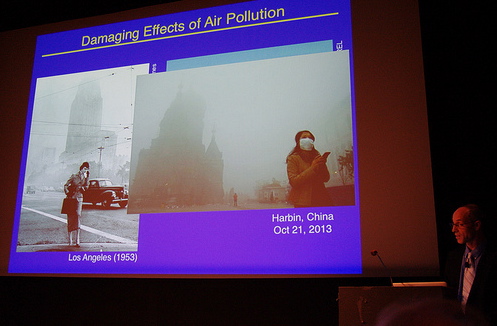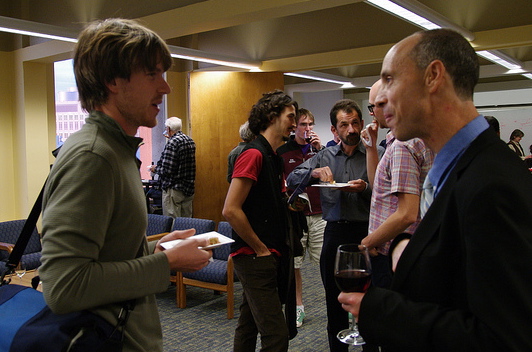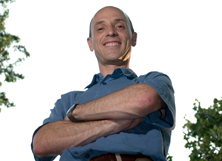Featured Stories | October 27, 2013
“We Can and We Must:” Drew Shindell on Air Pollution and Climate Change Action
By Genevieve Wanucha
On Monday October 21, climatologist Drew Shindell came up from New York City’s NASA Goddard Institute for Space Studies (GISS) to give the 13th Annual Henry W. Kendall Memorial Lecture, which filled nearly every seat in MIT Media Lab’s Bartos Theater. His eye-opening talk, “How Air Pollution Affects Climate and What We Can Do About It,” urged more creative thinking about how to deal with the consequences of the greenhouse gases and aerosols we put into the sky.
You may have heard of the “Faustian bargain” that policymakers face in cleaning up air pollution. Coal-fired power plants, a major source of carbon dioxide (CO2) emissions, also emit sulfate aerosols. Unlike CO2, which warms the planet, sulfate aerosols cool the atmosphere and oceans by absorbing and reflecting sunlight away from the planet, essentially offsetting much of the warming that we would otherwise incur. So, by reducing sulfate air pollution (without also reducing CO2 emissions), we actually worsen near-term global warming. (See: The Global Warming Conundrum for an ocean slant) Going this route, “from a climate perspective, is absolutely the last place we want to go,” said Shindell. He described another plan to simultaneously reduce climate change and improve air quality.
Shindell’s idea rests on the fact that the climate forcing agents we emit have different lifetimes in the atmosphere, which govern the roles each play in global warming. For example, of the CO2 we have already emitted, about eighty percent will be absorbed into the ocean over the next several hundred years, but twenty percent will stay in the atmosphere for millenia. Methane, carbon monoxide, and black carbon also warm the planet, but these agents are short-lived. Methane stays in the atmosphere for a decade; black carbon hangs around only a few days. When we stop or decrease emissions, their warming effect will disappear relatively quickly, whereas warming from CO2 remains, as far as humans are concerned, essentially forever.

These different time-scales set up a trade-off of priorities. If you care about limiting long-term climate change and ocean acidification, cutting CO2 is all that really matters. But, Shindell argued, there are very good reasons to consider slashing emissions of the short-lived agents. Not only do methane, black carbon, and carbon monoxide contribute to the warming already shifting ecosystems, they also degrade air quality. Indoor and outdoor air pollution together add up to the second leading risk factor for preventable death worldwide. To Shindell, acting on the short-lived climate forcers that double as air pollutants is a no-brainer–especially when there are cost-effective, practical ways that could be implemented now.
Drawing on a bevy of results from the 2013 Fifth Assessment Report of the Intergovernmental Panel on Climate Change, recent UNEP assessments, and from his own modeling research at GISS, he made the case that cutting methane and black carbon and co-emitted carbon monoxide would reap huge benefits to human health and agriculture in developing countries and lower near-term global warming everywhere. Everybody wins.
Most importantly, cost-effective and economically viable strategies to reduce emissions of short-lived pollutants exist now. For example, Shindell pointed out, in the northern Mexican city of Monterrey, land-fill capture of methane generates electricity for the city’s street lights. The widespread installation of alternative cook stoves in Senegal is saving women and children from breathing in the smoke released from traditional stoves. New York City has just started cost-saving organic waste recycling.

Shindell chairs the Scientific Advisory Panel of the Climate and Clean Air Coalition to Reduce Short-Lived Climate Pollutants, which is working to catalyze more such projects. “It will take creativity, will, and leadership,” he said.
As Shindell made clear at the start of his talk, even the most innovative reductions in short-lived climate forcing agents won’t impact the long-term global warming due to CO2 emissions. “There’s just no getting around the fact that over the long-term, CO2 emissions have to drop precipitously if we don’t want high radiative forcing,” he said. “But I think it is an unproductive discussion to debate whether acting on long or short-term concerns are more important. It is simply that we can and must do both, and what we shouldn’t do is, like with air quality regulation, wait over 100 years and only act once there is disaster. When cost effective solutions and technology already exist, we should go ahead and put them into place.”






